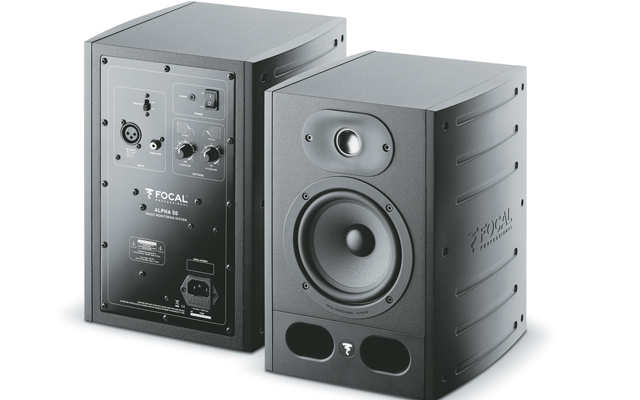Earlier this year, I made the decision sell the small bungalow I’ve called home for years, and build a new home in the ’burbs. That meant moving into a small apartment for the first time in a long time, and revisiting what it means to be “space constrained.” (As I write this review, moving in is still two months out, and I’m still struggling with those constraints.)
While the new house will include the realization of a long-awaited dream—a dedicated space for a true home-music studio—figuring out how to make music in the small apartment bedroom that serves as both studio and office has had its challenges, and that led me to finally evaluate near-field monitors of more diminutive size—sizes I wouldn’t normally consider due to the spectral trade-offs. That, in turn, led me to the Focal Alpha 50.
Focal-JMlab may not be that well-known to some in the United States; they are of French origin, based in Saint-Étienne in east-central France. The company manufactures a wide range of speakers for a wide range of applications, from multimedia, car, HiFi and powered studio monitors.
Focal introduced its new Alpha monitor line at MusikMesse in Frankfurt, Germany, this past March, and like many monitor lines in this price category, they come in three flavors reflecting the size of the main driver. The Alpha 50 has a 5-inch main driver, the Alpha 65 a 6.5-inch one, and of course, the Alpha 80 sports an 8-inch driver. All three sport Focal’s trademark “inverted dome” tweeter. For this review, I looked at the compact Alpha 50.
The Basics: On the power handling side, the Alpha 50s include an integrated 35-watt Class AB amplifier to handle the low-end, and with a 20-watt amplifier for the high end. The wattages go up considerably across the family (the Alpha 80s have 100-watt and 40-watt amps, respectively, for example).
On frequency response, the entire Alpha family covers up to 22 kHz, with the bottom end going as low as 35 Hz on the 80s, 40 Hz on the 65s, and just 45 Hz on the tested Alpha 50s. That 10 Hz spread between the 80s and the 50s doesn’t sound like much, but at the low end of the spectrum, it makes a pretty big difference, and especially for EDM, it would be pretty difficult in my view to accurately master a track with the usual thumpy, deep kick drum that’s felt as much as heard when using the Alpha 50s. But that’s not to suggest that the low end is absent; the drivers are large enough to deliver some low-end punch, accentuated by the front-facing ports, and they’d be more than up to the task of general production work.
Across the midrange and high-end, the Alpha 50s were crisp, and when listening to tracks and projects I know well, I found them to be accurate, delivering audio that seemed even and free from added “color,” just as you’d expect from a proper studio monitor. (I’m quick to point out that my comments are based on empirical observation, and not laboratory evaluation.)
Speaking of frequency response, I did like Focal’s choice of putting continuously variable adjustments for low and high end on the back to tune the monitors to your listening environment. Many monitors in this price range have fixed-selectable switches that sometimes don’t deliver the boost or cut you actually need. On the low end, you can dial in up to a 6 db boost, or 6 db cut; on the high-end, it’s 3 db in either the boost or cut direction—adjustments that should cover most bases.
While we’re looking at the back panel, we can see the two available input options: XLR balanced, and RCA unbalanced, and nearby is a sensitivity switch to control overall gain between 0 db and +6 db (the former working best for my environment).
Also on the back panel is a small red “standby” LED indicator. Perhaps one of my favorite features of the Alpha 50s is their auto-standby mode. After roughly 30 minutes without an audio signal, the monitors automatically go into standby, consuming less than half a watt of power. One quickly gets into the habit of slowly raising the master outputs from zero when getting down to business; as long as there’s audio to heard, the monitors will power up quickly on their own. While I’m not sure just how much juice a pair of monitors might consume toward the monthly electricity bill, I’m interested in saving everything I can, so this simple, elegant feature is particularly welcome. (It’s worth noting, too, that the Focal logos on the front of the monitors are illuminated when the monitors are out of standby, and go dark when standby mode is entered, just as if you’d turned them completely off.)
Finally, I have to give Focal kudos for an attractive offering. Monitors are monitors, I suppose, but the combination of vinyl-covered ½-inch MDF with molded plastic side panels give the product a sleek, modern look I really liked.
Conclusions: I found the Focal Alpha 50 studio monitors to be a great choice given the limited space in my temporary apartment situation. With a nice, even sound and compact size, I was rather hoping the company would let me keep them until it was time to move to my larger digs. In any case, at $299 each (MAP), or about $600 for a pair, they start touching the higher end of the price range for monitors in this class, but small differentiators like automatic standby mode and continuously variable frequency tailoring, may make the bit of extra spend justifiable for many users.







